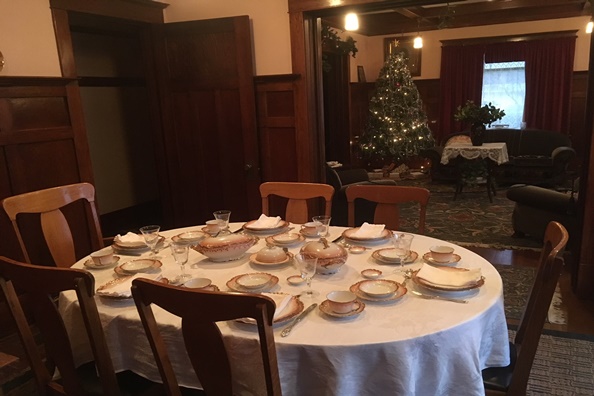At a time when retail stores are busy, the malls overcrowded and traffic seems insane, Trethewey House becomes an oasis. Once the Christmas tree has gone up, and the house has been decorated, a silent peace falls over the place. Visitors come in for a break from the hustle and bustle. The old heritage house is at its finest, and seems to sparkle even more than usual. All the silver is polished, the wainscoting oiled, and the best dishes cleaned and laid out. It wouldn’t be a real Christmas House without the holly, and it’s not really Christmas until we’ve hung the mistletoe. Of course, the real star of the show is the Christmas tree, decked out to the nines with historic decorations. There are glass balls, tin icicles, gilded walnuts, and lights. And here is tinsel. Lots of tinsel.
Christmas at the Museum: All that Glitters isn’t Gold Tinsel
Older than You Might Think
The Trethewey family, who built the home in 1919, were fortunate to have electricity, a forced air furnace, running water, a flushing toilet and even a central vacuum cleaner. The fact that they had electricity meant they could have electric lights in their tree. Because most people would have used the old-fashioned candles in their trees, we at the museum also hang some of those.
The idea is that all that tinsel and the beautiful glass and gold ornaments reflect the light from the candles and lights. As a matter of fact, the very first tinsel, first produced in 1610, was made of shredded silver. That was obviously not something a regular household could afford, and so cheaper alternatives were invented. The tradition of decorating with it thus spread to less affluent households, and tinsel is now a staple item at Christmas.
Tinsel for Flappers
In the museum’s collection, we have some of these cheaper alternatives, like aluminum and copper. The bonus: unlike silver, copper doesn’t tarnish, and the tinsel could be reused annually. Copper tinsel was, however, a relatively short lived holiday item. It became popular just before World War I. As with all the other “non-essential” metals items – including the metal bits used to make ladies corsets – the metal was needed for the war effort.
Out with the corsets and the copper tinsel, and in with “waistless” flapper dresses and aluminum Christmas décor. In the 1950s, Christmas trees made of aluminized paper were the latest craze, but much like the aluminized paper tinsel, the material was very flammable. That was obviously not a good thing as many still employed open flame candles. Even the electric lights were hot enough to cause the aluminum to go up in smoke.
Space Age Tinsel
Next came lead foil and lead-and-tin. Lead-and tin tinsel was made by bonding tin to the outside of lead. That stuff gave a serious sparkle when paired with lights or candles. As with copper and aluminum, and unlike silver, it did not tarnish. Of course, today there is no way we’d be wanting our kids around that stuff (not that we’d want them around open flame in a dry Christmas tree, for that matter…), but lead tinsel ruled the market until the early 1970s.
The present author can still remember a time when asbestos “angel hair” was used in Christmas trees as well, also well into the 70s. Today’s tinsel is made with plastic, PVC film as a matter of fact, and Angel Hair isn’t used at all. In the Trethewey House Christmas tree, we use 1920s aluminum tinsel icicles, as well as some of the old style tinsel garlands
Decking the Halls with More than Holly
The museum will soon be closed for the holidays. In the New Year, staff will return to “tear down”. That’s such a brutal sounding term for what is actually one of the most gentle handling procedures we do all year. Tear down is the time of year when staff is reminded why we had to get trained to do this job.
Each cataloged item is carefully placed into its own place with gloved hands. Icicles gets teased off of the tree and placed in acid free paper which is laid flat in another acid free box. Each item is then inventoried into the catalogue and replaced in exactly the spot it was taken from a month ago. Hundreds of ornaments go back to their “home shelves”. But next year, you can bank on it; they will all be brought out and used to deck the House’s halls with more than holly.
Main Image Credit: Christina Reid Trethewey House Heritage Site


